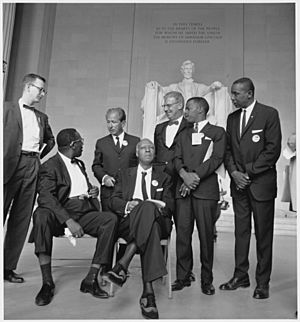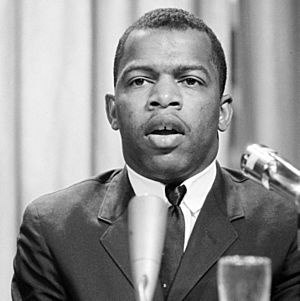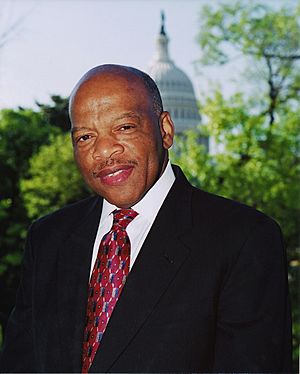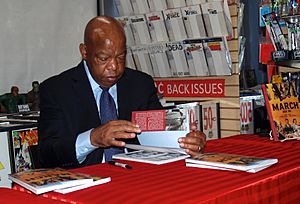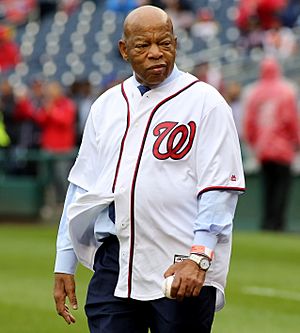John Lewis facts for kids
Quick facts for kids
John Lewis
|
|
|---|---|
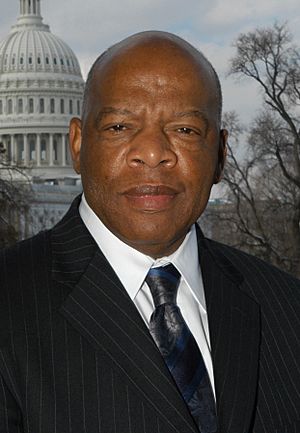
Lewis in 2006
|
|
| House Democratic Senior Chief Deputy Whip | |
| In office January 3, 2003 – July 17, 2020 |
|
| Leader | Dick Gephardt Nancy Pelosi |
| Preceded by | Position established |
| Succeeded by | G. K. Butterfield |
| Member of the U.S. House of Representatives from Georgia's 5th district |
|
| In office January 3, 1987 – July 17, 2020 |
|
| Preceded by | Wyche Fowler |
| Succeeded by | Kwanza Hall |
| Member of the Atlanta City Council from at-large post 18 |
|
| In office January 1, 1982 – September 3, 1985 |
|
| Preceded by | Jack Summer |
| Succeeded by | Morris Finley |
| 3rd Chairman of the Student Nonviolent Coordinating Committee | |
| In office June 1963 – May 1966 |
|
| Preceded by | Charles McDew |
| Succeeded by | Stokely Carmichael |
| Personal details | |
| Born |
John Robert Lewis
February 21, 1940 Pike County, Alabama, U.S. |
| Died | July 17, 2020 (aged 80) Atlanta, Georgia, U.S. |
| Resting place | South-View Cemetery |
| Political party | Democratic |
| Spouse |
Lillian Miles
(m. 1968; died 2012) |
| Children | 1 |
| Education |
|
| Occupation |
|
| Signature |  |
John Robert Lewis (February 21, 1940 – July 17, 2020) was an American politician and civil rights activist who fought to end racial segregation in the United States. In 1961, Lewis became one of the 13 original Freedom Riders. He was one of the so called "Big Six", leaders who organized the 1963 March on Washington. In 1965 Lewis became nationally known during his prominent role in the Selma to Montgomery marches.
Contents
Early life and education
John Robert Lewis was born near Troy, Alabama, on February 21, 1940. He was the third of ten children of Willie Mae (née Carter) and Eddie Lewis. His parents were sharecroppers in rural Pike County, Alabama, of which Troy was the county seat.
As a young child, Lewis had little interaction with white people, as his county was majority black by a large percentage and his family worked as farmers. By the time he was six, Lewis had seen only two white people in his life. Lewis recalls "I grew up in rural Alabama, very poor, very few books in our home."
He describes his early education at a little school, walking distance from his home. "A beautiful little building, it was a Rosenwald School. It was supported by the community, it was the only school we had." "I had a wonderful teacher in elementary school, and she told me 'read my child, read!' And I tried to read everything. I loved books. I remember in 1956, when I was 16 years old, with some of my brothers and sisters and cousins, going down to the public library, trying to get a library card, and we were told the library was for whites only." As he grew older, he began taking trips into Troy with his family, where he continued to have experiences of racism and segregation. Lewis had relatives who lived in northern cities, and he learned from them that in the North schools, buses, and businesses were integrated. When Lewis was 11, an uncle took him to Buffalo, New York, where he became acutely aware of the contrast with Troy's segregation.
In 1955, Lewis first heard Martin Luther King Jr. on the radio, and he closely followed King's Montgomery bus boycott later that year.
After writing to King about being denied admission to Troy University in Alabama, Lewis was invited to meet with him. King, who referred to Lewis as "the boy from Troy", discussed suing the university for discrimination, but he warned Lewis that doing so could endanger his family in Troy. After discussing it with his parents, Lewis decided instead to proceed with his education at a small, historically black college in Tennessee.
Lewis graduated from the American Baptist Theological Seminary in Nashville, Tennessee, and was ordained as a Baptist minister. He then earned a bachelor's degree in religion and philosophy from Fisk University, also a historically black college, where he was a member of Phi Beta Sigma fraternity.
Activism
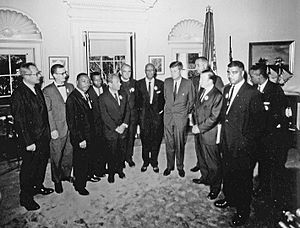
As a student, Lewis became an activist in the civil rights movement. He organized sit-ins at segregated lunch counters in Nashville and took part in many other civil rights activities as part of the Nashville Student Movement. The Nashville sit-in movement was responsible for the desegregation of lunch counters in the city's downtown. Lewis was arrested and jailed many times during the nonviolent activities to desegregate the city's downtown businesses. He was also instrumental in organizing bus boycotts and other nonviolent protests to support voting rights and racial equality.
During this time, Lewis said it was important to engage in "good trouble, necessary trouble" in order to achieve change, and he held to this credo throughout his life.
Freedom Riders
The Freedom Ride was initiated to pressure the federal government to enforce the Supreme Court decision in Boynton v. Virginia (1960) that declared segregated interstate bus travel to be unconstitutional. At 21, Lewis was one of 13 original Freedom Riders, who were beaten by angry mobs and arrested.
In Rock Hill, South Carolina, he was assaulted when he tried to enter a whites-only waiting room. Two weeks later Lewis joined a "Freedom Ride" bound for Jackson, Mississippi. Near the end of his life, Lewis said of this time, "We were determined not to let any act of violence keep us from our goal. We knew our lives could be threatened, but we had made up our minds not to turn back." As a result of his Freedom Rider activities, Lewis was imprisoned for 40 days in the notorious Mississippi State Penitentiary in Sunflower County.
When CORE gave up on the Freedom Ride because of the violence, Lewis and fellow activist Diane Nash arranged for Nashville students from Fisk and other colleges to take it over and bring it to a successful conclusion.
SNCC Chairman
In 1963, when Charles McDew stepped down as chairman of the Student Nonviolent Coordinating Committee (SNCC), Lewis was elected to take over. Lewis had already been arrested 24 times in the nonviolent movement for equal justice. He served as SNCC chairman until 1966, when he was replaced by Stokely Carmichael.
As chairman of SNCC, Lewis was one of the "Big Six" leaders who were organizing the March on Washington that summer. The youngest, he was scheduled as the fourth to speak, ahead of the final speaker, Dr. Martin Luther King. Other leaders were Whitney Young, A. Philip Randolph, James Farmer, and Roy Wilkins.
In 1964, SNCC opened Freedom Schools, launched the Mississippi Freedom Summer for voter education and registration. Lewis coordinated SNCC's efforts for Freedom Summer, a campaign to register black voters in Mississippi and to engage college student activists in aiding the campaign. Lewis traveled the country, encouraging students to spend their summer break trying to help people vote in Mississippi, which had the lowest number of black voters and strong resistance to the movement.
Selma to Montgomery marches
In 1965, Lewis led the first of three Selma to Montgomery marches. On March 7, 1965 – a day that would become known as "Bloody Sunday" – Lewis and fellow activist Hosea Williams led over 600 marchers across the Edmund Pettus Bridge in Selma, Alabama. At the end of the bridge and the city-county boundary, they were met by Alabama State Troopers who ordered them to disperse. When the marchers stopped to pray, the police discharged tear gas and mounted troopers charged the demonstrators, beating them with nightsticks. Lewis's skull was fractured, but he was aided in escaping across the bridge to Brown Chapel, a church in Selma that served as the movement's headquarters. Lewis bore scars on his head from this incident for the rest of his life.
Field Foundation, SRC, and VEP (1966–1977)
In 1966, Lewis moved to New York City to take a job as the associate director of the Field Foundation. He was there a little over a year before moving back to Atlanta to direct the Southern Regional Council's Community Organization Project. During his time with the SRC, he completed his degree from Fisk University.
In 1970, Lewis became the director of the Voter Education Project (VEP), a position he held until 1977. Though initially a project of the Southern Regional Council, the VEP became an independent organization in 1971. Despite difficulties caused by the 1973–1975 recession, the VEP added nearly four million minority voters to the rolls under Lewis's leadership. During his tenure, the VEP expanded its mission, including running Voter Mobilization Tours.
Political career


Lewis was first elected to the U.S. House of Representatives in 1986 and served 17 terms. The district he represented included most of Atlanta. Due to his length of service, he became the dean of the Georgia congressional delegation. Lewis was one of the leaders of the Democratic Party in the House, serving from 1991 as a chief deputy whip and from 2003 as a senior chief deputy whip.
Lewis drew on his historical involvement in the Civil Rights Movement as part of his politics. He made an annual pilgrimage to Alabama to retrace the route he marched in 1965 from Selma to Montgomery – a route Lewis worked to make part of the Historic National Trails program.
Committee assignments
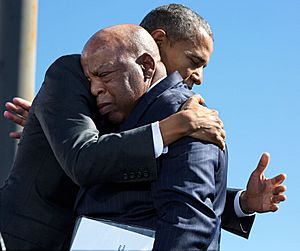
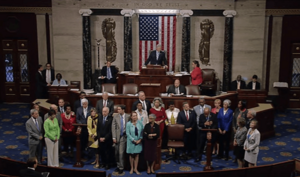
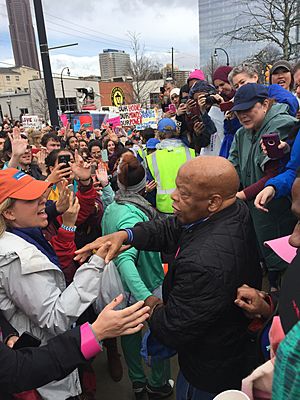
Lewis served on the following Congressional committees at the time of his death:
- Committee on Ways and Means
- Subcommittee on Oversight (Chair)
- United States Congress Joint Committee on Taxation
Caucus memberships
Lewis was a member of over 40 caucuses, including:
- Chronic Obstructive Pulmonary Disease (COPD) Caucus (Co-Chair)
- Congressional Structured Settlements Caucus (Co-Chair)
- Congressional Black Caucus
- Congressional Progressive Caucus
- Congressional Brazil Caucus
- Congressional Arts Caucus
In 1991, Lewis became the senior chief deputy whip in the Democratic caucus.
National African American Museum
In 1988, the year after he was sworn into Congress, Lewis introduced a bill to create a national African American museum in Washington. The bill failed, and for 15 years he continued to introduce it with each new Congress. Each time it was blocked in the Senate, most often by conservative Southern Senator Jesse Helms. In 2003, Helms retired. The bill won bipartisan support, and President George W. Bush signed the bill to establish the museum, with the Smithsonian's Board of Regents to establish the location. The National Museum of African American History and Culture, located adjacent to the Washington Monument, held its opening ceremony on September 25, 2016.
Biographies
Lewis's 1998 autobiography Walking with the Wind: A Memoir of the Movement, co-written with Mike D'Orso, won the Robert F. Kennedy Book Award, the Anisfield-Wolf Book Award, the Christopher Award and the Lillian Smith Book Award. It appeared on numerous bestseller lists, was selected as a New York Times Notable Book of the Year, was named by the American Library Association as its Nonfiction Book of the Year, and was included among Newsweek magazine's 2009 list of "50 Books For Our Times".
His life is also the subject of a 2002 book for young people, John Lewis: From Freedom Rider to Congressman. In 2012, Lewis released Across That Bridge, written with Brenda Jones.
March (2013)
In 2013, Lewis became the first member of Congress to write a graphic novel, with the launch of a trilogy titled March. The March trilogy is a black and white comics trilogy about the Civil Rights Movement, told through the perspective of civil rights leader and U.S. Congressman John Lewis. The first volume, March: Book One is written by Lewis and Andrew Aydin, illustrated and lettered by Nate Powell and was published in August 2013, the second volume, March: Book Two was published in January 2015 and the final volume, March: Book Three was published in August 2016.
March: Book One received an "Author Honor" from the American Library Association's 2014 Coretta Scott King Book Awards, which honors an African American author of a children's book. Book One also became the first graphic novel to win a Robert F. Kennedy Book Award, receiving a "Special Recognition" bust in 2014.
March: Book One was selected by first-year reading programs in 2014 at Michigan State University, Georgia State University, and Marquette University.
March: Book Two was released in 2015 and immediately became both a New York Times and Washington Post bestseller for graphic novels.
The release of March: Book Three in August 2016 brought all three volumes into the top 3 slots of the New York Times bestseller list for graphic novels for 6 consecutive weeks. The third volume was announced as the recipient of the 2017 Printz Award for excellence in young-adult literature, the Coretta Scott King Award, the YALSA Award for Excellence in Nonfiction, the 2016 National Book Award in Young People's Literature, and the Sibert Medal at the American Library Association's annual Midwinter Meeting in January 2017.
The March trilogy received the Carter G. Woodson Book Award in the Secondary (grades 7–12) category in 2017.
Run (2018)
In 2018, Lewis and Andrew Aydin co-wrote another graphic novel as a sequel to the March series entitled Run, which documents Lewis's life after the passage of the Civil Rights Act. The authors teamed with illustrator Afua Richardson for the book, which was originally scheduled to be released in August 2018, but was later rescheduled. It was released on August 3, 2021, a year after his death, as it was one of his last endeavours before he died. Nate Powell, who illustrated March, also contributed to the art.
Personal life
Lewis met Lillian Miles at a New Year's Eve party hosted by Xernona Clayton. They married in 1968. In 1976, they adopted one son, named John-Miles Lewis. Lillian died on December 31, 2012.
Illness and death
On December 29, 2019, Lewis announced that he had been diagnosed with stage IV pancreatic cancer. He remained in the Washington D.C. area for his treatment. Lewis stated: "I have been in some kind of fight – for freedom, equality, basic human rights – for nearly my entire life. I have never faced a fight quite like the one I have now."
On July 17, 2020, Lewis died at the age of 80 after suffering from the disease for 8 months in Atlanta, on the same day as his friend and fellow civil rights activist C.T. Vivian. Lewis had been the final surviving "Big Six" civil rights icon.
Then-president Donald Trump ordered all flags to be flown at half-staff in response to Lewis's death.
Interesting facts about John Lewis
- As a boy, Lewis aspired to be a preacher, and at age five, he preached to his family's chickens on the farm.
- Lewis met Rosa Parks when he was 17 and Martin Luther King Jr. at 18.
- Lewis was the only living speaker from the March on Washington present on the stage during the inauguration of Barack Obama. Obama signed a commemorative photograph for Lewis with the words, "Because of you, John. Barack Obama."
- On Barack Obama being elected president, Lewis said, "If you ask me whether the election ... is the fulfillment of Dr. King's dream, I say, 'No, it's just a down payment.' There's still too many people 50 years later, there's still too many people that are being left out and left behind."
- After his death, Lewis became the first African-American lawmaker to lie in state in the United States Capitol Rotunda.
- In 2001, the John F. Kennedy Library Foundation awarded Lewis the Profile in Courage Award "for his extraordinary courage, leadership and commitment to civil rights". It is a lifetime achievement award and has been given out only twice, to John Lewis and William Winter (in 2008).
John Lewis quotes
- "When you see something that is not right, not fair, not just, you have to speak up. You have to say something; you have to do something."
- Freedom is not a state; it is an act. It is not some enchanted garden perched high on a distant plateau where we can finally sit down and rest. Freedom is the continuous action we all must take, and each generation must do its part to create an even more fair, more just society."
- "I believe in nonviolence as a way of life, as a way of living."
- "We may not have chosen the time, but the time has chosen us."
- "Do not get lost in a sea of despair. Be hopeful, be optimistic. Our struggle is not the struggle of a day, a week, a month, or a year, it is the struggle of a lifetime. Never, ever be afraid to make some noise and get in good trouble, necessary trouble."
Honors
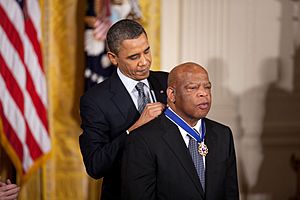
Lewis was honored by having the 1997 sculpture by Thornton Dial, The Bridge, placed at Ponce de Leon Avenue and Freedom Park, Atlanta, dedicated to him by the artist. In 1999, Lewis was awarded the Wallenberg Medal from the University of Michigan in recognition of his courageous lifelong commitment to the defense of civil and human rights. In that same year, he received the Four Freedoms Award for the Freedom of Speech.
Lewis was also awarded the Spingarn Medal from the NAACP.
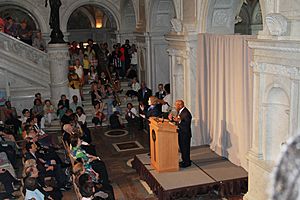
In 2004, Lewis received the Golden Plate Award of the American Academy of Achievement presented by Awards Council member James Earl Jones.
In 2006, he received the U.S. Senator John Heinz Award for Greatest Public Service by an Elected or Appointed Official, an award given out annually by Jefferson Awards for Public Service. In September 2007, Lewis was awarded the Dole Leadership Prize from the Robert J. Dole Institute of Politics at the University of Kansas.
In 2010, Lewis was awarded the First LBJ Liberty and Justice for All Award, given to him by the Lyndon Baines Johnson Foundation, and the next year, Lewis was awarded the Presidential Medal of Freedom by President Barack Obama.
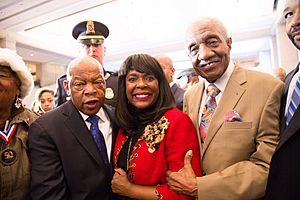
In 2016, it was announced that a future United States Navy underway replenishment oiler would be named USNS John Lewis. Also in 2016, Lewis and fellow Selma marcher Frederick Reese accepted Congressional Gold Medals which were bestowed to the "foot soldiers" of the Selma marchers. The same year, Lewis was awarded the Liberty Medal at the National Constitution Center. The prestigious award has been awarded to international leaders from Malala Yousafzai to the 14th Dalai Lama, presidents George Bush and Bill Clinton and other dignitaries and visionaries. The timing of Lewis's award coincided with the 150th anniversary of the 14th amendment. In 2020, Lewis was awarded the Walter P. Reuther Humanitarian Award by Wayne State University, the UAW, and the Reuther family.
Lewis gave numerous commencement addresses, including at the School of Visual Arts (SVA) in 2014, Bates College (in Lewiston, Maine) and Washington University in St. Louis in 2016, Bard College and Bank Street College of Education in 2017, and Harvard University in 2018.
Lewis was recognized for his involvement with comics with the 2017 Inkpot Award.
Lewis's death in July 2020 has given rise to support for renaming the historically significant Pettus bridge in Lewis's honor, an idea previously floated years ago. After his death, the Board of Fairfax County Public Schools announced that Robert E. Lee High School in Springfield, Virginia would be renamed John R. Lewis High School.
Following his death, Troy University announced that the main building on its flagship campus would bear the name of John Lewis.
On July 30, 2018, the Atlanta City Council voted to rename Atlanta's Freedom Parkway John Lewis Freedom Parkway. On November 5, 2020, the Metropolitan Council of Nashville and Davidson County voted to rename an extensive part of Nashville, Tennessee's 5th Avenue John Lewis Way.
On August 1, 2020, a statue of Lewis was revealed by sculptor Gregory Johnson. The statue was commissioned by Rodney Mims Cook Jr. and was installed at Cook Park in Atlanta, Georgia, in April 2021.
On February 21, 2021, President Joe Biden marked Lewis's late birthday on Sunday, urging all Americans to “carry on his mission in the fight for justice and equality for all.” He tweeted, “While my dear friend may no longer be with us, his life and legacy provide an eternal moral compass on which direction to march. May we carry on his mission in the fight for justice and equality for all.”
On October 27, 2021, the University of California, Santa Cruz named one of its residential colleges, formerly known as College Ten, John R Lewis College.
Honorary academic degrees
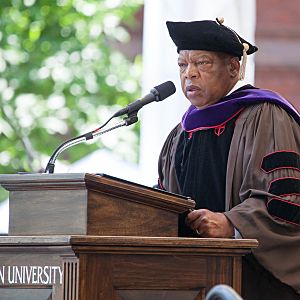
Lewis was awarded more than 50 honorary degrees, including:
- 1989: Honorary Doctor of Laws degree from Troy State University (now Troy University)
- 1995: Honorary Doctor of Public Service degree from Northeastern University
- 1998: Honorary Humane Letters degree from Brandeis University
- 1999: Honorary Doctor of Laws degree from the University of Massachusetts Boston
- 1999: Honorary Doctor of Laws degree from Knox College
- 2001: Honorary Doctor of Laws degree from University at Albany
- 2002: Honorary D.H.L. from Howard University
- 2003: Honorary Doctor of Laws degree from the College of Wooster
- 2004: Honorary degree from Portland State University
- 2004: Honorary LHD from Juniata College
- 2007: Honorary LL.D. degree from the University of Vermont
- 2007: Honorary LL.D. degree from Adelphi University
- 2012: Honorary LL.D. degrees from Brown University, University of Pennsylvania, Harvard University, and the University of Connecticut School of Law
- 2013: Honorary Doctor of Humane Letters from Judson College
- 2013: Honorary LL.D. degrees from Cleveland State University and Union College
- 2014: Honorary LL.D. degree from Emory University
- 2014: Honorary Doctorate of Fine Arts from the School of Visual Arts.
- 2014: Honorary Bachelor of Arts from Lawrence University.
- 2014: Honorary Doctor of Letters degree from Marquette University
- 2015: Honorary Doctorate of Humane Letters from the McCourt School of Public Policy, Georgetown University.
- 2015: Honorary Doctor of Humane Letters from Lawrence University
- 2015: Honorary degree from Goucher College
- 2015: Honorary Doctor of Laws degree from Hampton University
- 2016: Honorary Doctorate of Humane Letters from New York University
- 2016: Honorary Doctor of Humane Letters from Bates College
- 2016: Honorary Doctor of Humane Letters from Washington University in St. Louis
- 2016: Honorary Doctor of Policy Analysis from the Frederick S. Pardee RAND Graduate School
- 2016: Honorary Doctor of Laws degree from Washington and Jefferson College
- 2017: Honorary Doctor of Laws degree from Yale University
- 2017: Honorary Doctor of Laws degree from Berea College
- 2017: Honorary Doctor of Humane Letters degree from Bank Street Graduate School of Education
- 2018: Honorary Doctor of Law degree from Boston University
- 2019: Honorary Doctor of Humane Letters degree from City College of New York
- 2019: Honorary Doctorate from Tulane University
See also
 In Spanish: John Lewis (político) para niños
In Spanish: John Lewis (político) para niños
- John Lewis Voting Rights Act
- List of African-American United States representatives
- List of civil rights leaders
- List of United States Congress members who died in office


